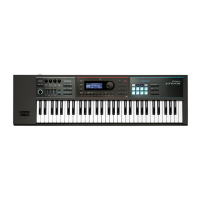15
Patch Mode
Parameter Value/Explanation
Velocity
Level
Fade Lower
Fade Upper
Range Lower Range Upper
PITCH
Parameter Value/Explanation
Tone Coarse Tune
Selects the pitch at which a tone sounds.
C- –G9
Tone Fine Tune
Adjusts the pitch of the tone’s sound up or down in 1-cent steps (±50
cents).
-50–+50
Tone Random
Pitch Depth
Species the width of random pitch deviation that will occur each time a
key is pressed. If you do not want the pitch to change randomly, set this to
“0.” These values are in units of cents (1/100th of a semitone).
0–1200
PITCH ENV
Parameter Value/Explanation
Pitch Env Depth
Adjusts the eect of the Pitch Envelope. Higher settings will cause the
pitch envelope to produce greater change. Negative (-) settings will invert
the shape of the envelope.
-12–+12
Pitch Env V-Sens
Keyboard playing dynamics can be used to control the depth of the pitch
envelope. If you want the pitch envelope to have more eect for strongly
played notes, set this parameter to a positive (+) value. If you want the
pitch envelope to have less eect for strongly played notes, set this to a
negative (-) value.
-63–+63
Pitch Env T1
V-Sens
This allows keyboard dynamics to aect the Time 1 of the Pitch envelope.
If you want Time 1 to be speeded up for strongly played notes, set this
parameter to a positive (+) value. If you want it to be slowed down, set this
to a negative (-) value.
-63–+63
Pitch Env T4
V-Sens
Use this parameter when you want key release speed to aect the Time
4 value of the pitch envelope. If you want Time 4 to be speeded up for
quickly released notes, set this parameter to a positive (+) value. If you
want it to be slowed down, set this to a negative (-) value.
-63–+63
Pitch Env Time 1–4
Specify the pitch envelope times (Time 1–Time 4). Higher settings will
result in a longer time until the next pitch is reached. (For example, Time 2
is the time over which the pitch changes from Level 1 to Level 2.)
0–127
Pitch Env Level
0–4
Specify the pitch envelope levels (Level 0–Level 4).
It determines how much the pitch changes from the reference pitch (the
value set with Coarse Tune or Fine Tune on the Pitch screen) at each point.
Positive (+) settings will cause the pitch to be higher than the standard
pitch, and negative (-) settings will cause it to be lower.
-63–+63
Note on
Note o
Time
Pitch
T: Time L: Level
TVF
Parameter Value/Explanation
Filter Type
Selects the type of lter. A lter cuts or boosts a specic frequency region
to change a sound’s brightness, thickness, or other qualities.
* If you set “LPF2” or “LPF3,” the setting for the Resonance will be ignored
(p. 15).
OFF No lter is used.
LPF
Low Pass Filter. This reduces the volume of all frequencies above
the cuto frequency in order to round o, or un-brighten the
sound. This is the most common lter used in synthesizers.
BPF
Band Pass Filter. This leaves only the frequencies in the region of
the cuto frequency, and cuts the rest. This can be useful when
creating distinctive sounds.
HPF
High Pass Filter. This cuts the frequencies in the region below the
cuto frequency. This is suitable for creating percussive sounds
emphasizing their higher tones.
PKG
Peaking Filter. This emphasizes the frequencies in the region of
the cuto frequency. You can use this to create wah-wah eects
by employing an LFO to change the cuto frequency cyclically.
LPF2
Low Pass Filter 2. Although frequency components above the
cuto frequency are cut, the sensitivity of this lter is half that of
the LPF. This makes it a comparatively warmer low pass lter. This
lter is good for use with simulated instrument sounds such as
the acoustic piano.
LPF3
Low Pass Filter 3. Although frequency components above the
cuto frequency are cut, the sensitivity of this lter changes
according to the cuto frequency. While this lter is also good
for use with simulated acoustic instrument sounds, the nuance
it exhibits diers from that of the LPF2, even with the same TVF
Envelope settings.
Cuto Frequency
Selects the frequency at which the lter begins to have an eect on the
waveform’s frequency components.
“LPF/LPF2/LPF3” selected for the Filter Type
Lower cuto frequency settings reduce a tone’s upper harmonics for a
more rounded, warmer sound. Higher settings make it sound brighter.
“BPF” selected for the Filter Type
Harmonic components will change depending on the TVF Cuto
Frequency setting. This can be useful when creating distinctive sounds.
“HPF” selected for the Filter Type
Higher Cuto Frequency settings will reduce lower harmonics to
emphasize just the brighter components of the sound.
“PKG” selected for the Filter Type
The harmonics to be emphasized will vary depending on Cuto Frequency
setting.
0–127
Resonance
Emphasizes the portion of the sound in the region of the cuto frequency,
adding character to the sound. Excessively high settings can produce
oscillation, causing the sound to distort.
0–127
Cuto V-Curve
Selects one of the following seven curves that determine how keyboard
playing dynamics (velocity) inuence the cuto frequency.
Set this to “FIXED” if you don’t want the Cuto frequency to be aected by
the keyboard velocity.
FIXED, 1–7
Cuto V-Sens
Use this parameter when changing the cuto frequency to be applied as a
result of changes in playing velocity. If you want strongly played notes to
raise the cuto frequency, set this parameter to positive (+) settings. If you
want strongly played notes to lower the cuto frequency, use negative (-)
settings.
-63–+63
Resonance V-Sens
This allows keyboard velocity to modify the amount of Resonance. If you
want strongly played notes to have a greater Resonance eect, set this
parameter to positive (+) settings. If you want strongly played notes to
have less Resonance, use negative (-) settings.
-63–+63

